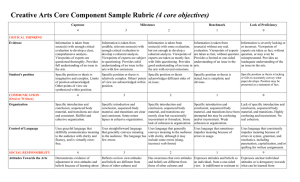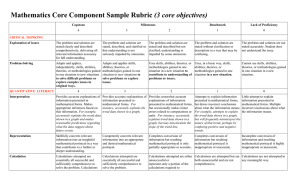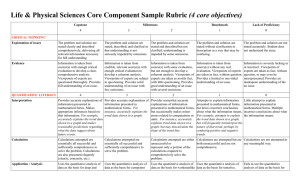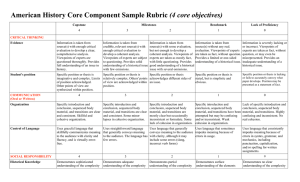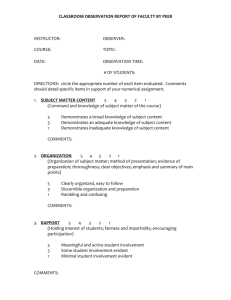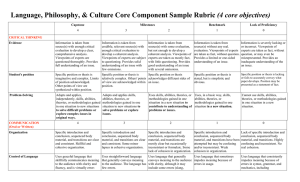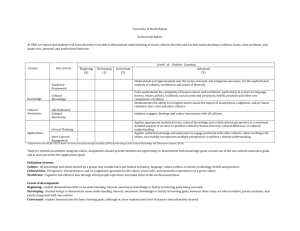(4 core objectives
advertisement
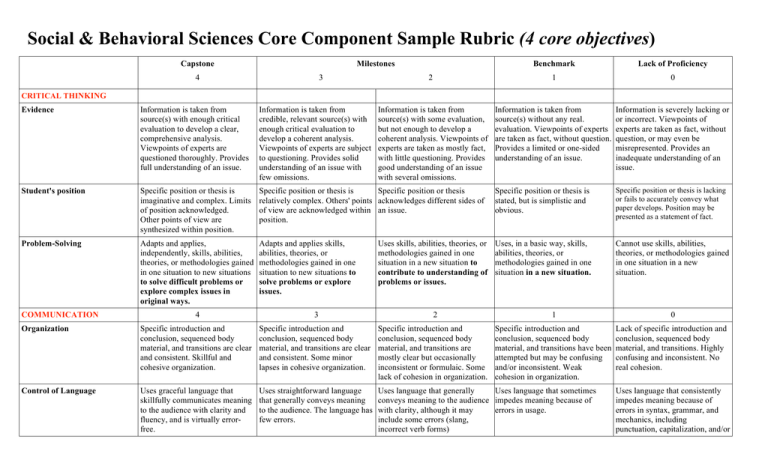
Social & Behavioral Sciences Core Component Sample Rubric (4 core objectives) Capstone Milestones 4 3 Benchmark Lack of Proficiency 2 1 0 Information is taken from source(s) with some evaluation, but not enough to develop a coherent analysis. Viewpoints of experts are taken as mostly fact, with little questioning. Provides good understanding of an issue with several omissions. Information is taken from source(s) without any real. evaluation. Viewpoints of experts are taken as fact, without question. Provides a limited or one-sided understanding of an issue. Information is severely lacking or or incorrect. Viewpoints of experts are taken as fact, without question, or may even be misrepresented. Provides an inadequate understanding of an issue. CRITICAL THINKING Evidence Information is taken from source(s) with enough critical evaluation to develop a clear, comprehensive analysis. Viewpoints of experts are questioned thoroughly. Provides full understanding of an issue. Information is taken from credible, relevant source(s) with enough critical evaluation to develop a coherent analysis. Viewpoints of experts are subject to questioning. Provides solid understanding of an issue with few omissions. Student's position Specific position or thesis is imaginative and complex. Limits of position acknowledged. Other points of view are synthesized within position. Specific position or thesis is Specific position or thesis relatively complex. Others' points acknowledges different sides of of view are acknowledged within an issue. position. Specific position or thesis is stated, but is simplistic and obvious. Specific position or thesis is lacking or fails to accurately convey what paper develops. Position may be presented as a statement of fact. Problem-Solving Adapts and applies, independently, skills, abilities, theories, or methodologies gained in one situation to new situations to solve difficult problems or explore complex issues in original ways. Adapts and applies skills, abilities, theories, or methodologies gained in one situation to new situations to solve problems or explore issues. Uses, in a basic way, skills, abilities, theories, or methodologies gained in one situation in a new situation. Cannot use skills, abilities, theories, or methodologies gained in one situation in a new situation. COMMUNICATION Uses skills, abilities, theories, or methodologies gained in one situation in a new situation to contribute to understanding of problems or issues. 4 3 2 1 0 Organization Specific introduction and conclusion, sequenced body material, and transitions are clear and consistent. Skillful and cohesive organization. Specific introduction and conclusion, sequenced body material, and transitions are clear and consistent. Some minor lapses in cohesive organization. Specific introduction and conclusion, sequenced body material, and transitions are mostly clear but occasionally inconsistent or formulaic. Some lack of cohesion in organization. Specific introduction and conclusion, sequenced body material, and transitions have been attempted but may be confusing and/or inconsistent. Weak cohesion in organization. Lack of specific introduction and conclusion, sequenced body material, and transitions. Highly confusing and inconsistent. No real cohesion. Control of Language Uses graceful language that skillfully communicates meaning to the audience with clarity and fluency, and is virtually errorfree. Uses straightforward language that generally conveys meaning to the audience. The language has few errors. Uses language that generally Uses language that sometimes conveys meaning to the audience impedes meaning because of with clarity, although it may errors in usage. include some errors (slang, incorrect verb forms) Uses language that consistently impedes meaning because of errors in syntax, grammar, and mechanics, including punctuation, capitalization, and/or spelling for written assignments. SOCIAL RESPONSIBILITY 4 3 2 1 0 Discipline Knowledge Demonstrates sophisticated understanding of the complexity of elements important in the course, whether sociology, social work, psychology, criminal justice, human development, economics, etc. Demonstrates adequate understanding of the complexity of elements important in the social science course. Demonstrates partial understanding of the complexity of elements important in the social science course. Demonstrates surface understanding of the elements important in the social science course. Demonstrates no clear understanding of the complexity of elements important in the social science course. Social Knowledge Analysis With insight and skill, connects and extends knowledge from classroom study of social sciences to current events and student's participation in the community. Connects knowledge from classroom study of social sciences to current events and student's participation in the community. Begins to connect knowledge from classroom study of social sciences to current events and student's participation in the community. Begins to identify knowledge from classroom study of social sciences that could be relevant to current events and student's participation in the community but makes few real connections. Fails to either identify or connect knowledge from classroom study of social sciences to current events or student's participation in the community. Social Engagement / Curiosity Asks complex questions about social sciences; describes what she/he has learned about her or himself for a clarified sense of community identity and commitment. Asks deeper questions about social sciences; describes what she/he has learned about her or himself for a growing sense of community identity and commitment. Asks simple or surface questions about social sciences; descriptions of self-knowledge seem generated from course requirements rather than from a sense of community identity or commitment. Conveys minimal interest in learning about social sciences; describes what she/he has learned about a personal community identity and commitment only in simplisitic or cliched terms. Shows no interest in learning about social sciences; fails to describe any new community identity or commitment. Attitudes Demonstrates evidence of adjustment in own attitudes and beliefs because of working within and learning from diversity of communities and cultures. Promotes others' engagement with diversity. Reflects on how own attitudes and beliefs are different from those of other cultures and communities. Exhibits curiosity about what can be learned from diversity of communities and cultures. Has awareness that own attitudes and beliefs are different from those of other cultures and communities. Exhibits little curiosity about what can be learned from diversity of communities and cultures. Expresses attitudes and beliefs as an individual, from a one-sided view. Is indifferent or resistant to what can be learned from diversity of communities and cultures. Expresses unclear individual attitudes or is derogatory towards what can be learned from diversity of communities and cultures. Provides accurate explanations of information presented in mathematical forms. Makes appropriate inferences based on that information. For example, accurately explains the trend data shown in a graph and makes reasonable predictions regarding Provides accurate explanations of information presented in mathematical forms. For instance, accurately explains the trend data shown in a graph. Provides somewhat accurate explanations of information presented in mathematical forms, but occasionally makes minor errors related to computations or units. For instance, accurately explains trend data shown in a graph, but may miscalculate the Attempts to explain information presented in mathematical forms, but draws incorrect conclusions about what the information means. For example, attempts to explain the trend data shown in a graph, but will frequently misinterpret the nature of that trend, perhaps by Little attempt to explain information presented in mathematical forms. Multiple incorrect conclusions about what the information means. EMPIRICAL / QUANTITATIVE SKILLS Interpretation what the data suggest about future events. Application / Analysis Uses the quantitative analysis of data as the basis for deep and thoughtful judgments, drawing insightful, carefully qualified conclusions from this work. Ex. student explains thoughtful ways to use the quantitative information and offers correctives Uses the quantitative analysis of data as the basis for competent judgments, drawing reasonable and appropriately qualified conclusions from this work. slope of the trend line. confusing positive and negative trends. Uses the quantitative analysis of data as the basis for workmanlike (without inspiration or nuance, ordinary) judgments, drawing plausible conclusions from this work. Uses the quantitative analysis of data as the basis for tentative, basic judgments, although is hesitant or uncertain about drawing conclusions from this work. Fails to use the quantitative analysis of data as the basis for any judgments. Draws little or no conclusions from this work. The following resources might assist you in filling out the Core Curriculum Request form. Texas Common Course Numbering System (TCCNS) Matrix This searchable online database lists classes that Prairie View A&M already accepts for specific transfer credit. The university also is updating its TCCNS articulation. http://www.tccns.org/matrix.aspx Lower-Division Academic Course Guide Manual This PDF gives the course descriptions for core classes as they must be offered at Texas community colleges. It may help you determine the proper TCCNS equivalent for the PVAMU core class you are requesting. http://www.thecb.state.tx.us/AAR/UndergraduateEd/WorkforceEd/acgm.htm Texas General Education Core Web Center This resource allows you to search the official PVAMU core as of 2003 and also to research courses allowed at other Texas colleges and universities. http://statecore.its.txstate.edu/ Overview of Planning General Education Assessment https://www.aalhe.org/sites/default/files/aalhe2011_gened.pdf Ideas for Assessing Critical Thinking http://www.aacu.org/resources/assessment/critical_thinking.cfm http://academic.pgcc.edu/~wpeirce/MCCCTR/Designingrubricsassessingthinking.html
